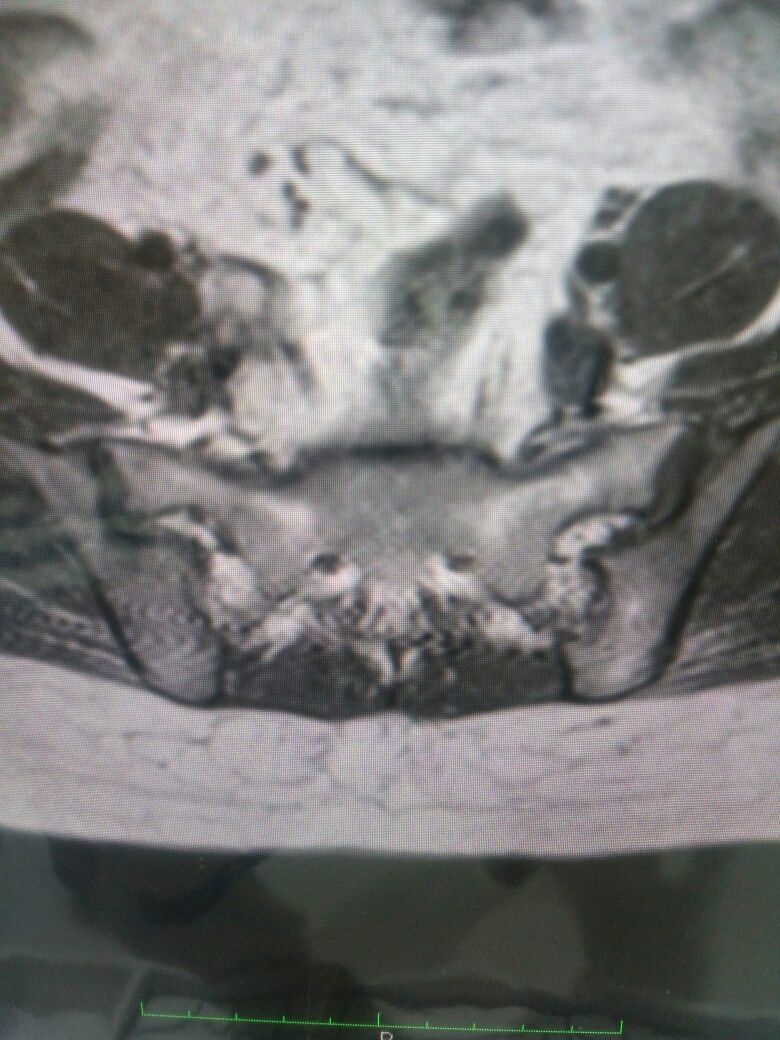Case studies
A rare co-occurrence of anti CCP-positive rheumatoid arthritis with sacroiliitis
Vikram Haridas1, Kiran Haridas2
Author Affiliations
1,2 Arthritis Super Speciality Center, Hubli, Karnataka, India
Correspondence: Dr. Vikram Haridas
IJRCI. 2019;7(1):CS1
Submitted: 3 November 2018, Accepted: 21 February 2019, Published: 23 February 2019
© IJRCI
Abstract
Sacroiliitis is considered as the most important sign of spondyloarthropathy. Rheumatoid arthritis mainly affects peripheral joints and the involvement of sacroiliac joint is very rare. The present case study discusses the rare existence of RA and concurrent chronic bilateral sacroiliitis.
Keywords: Rheumatoid arthritis, sacroiliitis, autoimmune diseases anti-CCP, sacroiliac joint
Introduction
Rheumatoid arthritis (RA) is a systemic, inflammatory joint disease featured by progressive damage of synovial-lined joints and functional disability.1,3 Articular and extraarticular presentations of arthritis include joint swelling, tenderness, and palpitation; frequently affecting metacarpophalangeal, proximal interphalangeal and metatarsophalangeal joints.1 The involvement of sacroiliac, distal interphalangeal, and lumbar spine joints is rarely observed in RA.1-4 The present case report deals with a rare co-existence of RA and chronic bilateral sacroiliitis.
Case report
A 32-year-old female presented to the outpatient clinic with a 3-months history of polyarthritis involving small joints of hands and feet. She had no other systemic symptoms like oral ulcers, plantar fasciitis, eye problems, or psoriasis. Her physical examination revealed swelling and tenderness in wrist and in small joints of hands and feet. No family history of spondyloarthritis was reported.
The results of laboratory investigations were as follows: hemoglobin (Hb): 12 mg/dl; total cell count (TC): 6500 cells/dl; erythrocyte sedimentation rate (ESR): 90 mm/1st hr, C-reactive protein (CRP): 23 mg/dl, rheumatoid factor (RF): 112 mg/dl; and anti-cyclic citrullinated peptide (anti-CCP): 332 units/dl.
She was diagnosed with seropositive RA, and was on methotrexate 7.5 mg per week and hydroxychloroquine 200 mg twice daily for six weeks. The patient was given depo-medrol 120 mg IM injection, on the day of diagnosis. Pain and swelling in the small joints subsided with the medication, but the mild lower backpain, aggravated over a period of 6 weeks and interfered with the routine activities. Tenderness was noted in sacroiliac joint with normal straight leg raising test, but Schober’s test was negative. MRI of sacroiliac joint confirmed chronic bilateral sacroiliitis (Fig. 1). HLA-B typing showed that she was positive for HLAB7:02 positive and negative for HLA- B27. The patient was treated with a short course of NSAIDs which subsided the pain within two weeks.
Fig. 1: MRI scan of sacroiliac joint
Discussion
The patient was initially diagnosed with anti-CCP positive RA, based on the laboratory investigations including positive RF and anti-CCP levels.
Inflammatory changes in the sacroiliac joint, referred as sacroiliitis, is considered as the paramount sign of spondyloarthritis, especially in axial spondyloarthritis.5, 6 Although the patient experienced tenderness in the sacroiliac joint, ankylosing spondylitis was not suspected, as she was negative for Schober’s test. Moreover, the absence of family history, and symptoms like oral ulcers, plantar fasciitis, eye problems, and psoriasis suggested the least possibility of spondyloarthritis.5-7
Even though the treatment for RA had reduced the pain and swelling of small joints, the aggravating lower back pain demanded further investigations. Hence MRI scan was performed, and the diagnosis was confirmed as chronic bilateral sacroiliitis. Her HLA-B typing showed positive for HLA-B7 antigen, however she was negative for HLA-B27. Thus, the final diagnosis was concluded as a rare occurrence of HLA-B7 positive sacroiliitis, with concurrent early anti-CCP positive RA.
A study by Parasannanavar et al. has noted a significant association between HLA-B*07 antigen and B27-negative spondyloarthropathy from Western India with majority of B*27 negative patients had undifferentiated spondyloarthritis.8 In addition, studies have reported that B*07 antigen plays a crucial role in the development of spondyloarthritis.8 There are literature findings reporting the association of seronegative RA with spondyloarthropathy conditions such as ankylosing spondylitis.3, 9, 10 Since the possibility for spondyloarthritis has been excluded in the current patient, the presence of sacroiliitis can be considered as an atypical joint involvement of RA.
Detection of inflammatory back diseases is often challenging. The literature evidence reporting the co-occurrence of bilateral sacroiliitis with RA is very limited. Calik et al., have reported the incidence of bilateral sacroiliitis in patient with late RA.11 Similar to the present case, Irfan et al, has noted the co-existence of bilateral sacroiliitis and early rheumatoid arthritis.12 Though rare, the present study highlights the need to consider the involvement of sacroiliac joint in patients diagnosed with RA.
Competing interests
The authors declare that they have no competing interests.
References
1. Grassi W, De Angelis R, Lamanna G, Cervini C. The clinical features of rheumatoid arthritis. Eur J Radiol 1998;27 Suppl1: S18-24.
2. Toussirot E, Acquaviva PC. Coexisting rheumatoid arthritis and ankylosing spondylitis discussion of 3 cases with review of the literature. Clin Rheumatol 1995;14(5):554–60.
3. Azevedo VF, Buiar PG. Concurrent rheumatoid arthritis and ankylosing spondylitis in one patient: the importance of new classification criteria. Rev Bras Reumatol 2013;53(1):115–9.
4. Arvikar SL, Fisher MC. Inflammatory bowel disease associated arthropathy. Curr Rev Musculoskelet Med 2011;4(3):123–31.
5. Spondyloarthritis [Internet]. [cited 2018 Oct 29]. Available from: https://www.rheumatology.org/I-Am-A/Patient-Caregiver/Diseases-Conditions/Spondyloarthritis.
6. Sudoł-Szopińska I, Urbanik A. Diagnostic imaging of sacroiliac joint and the spine in the course of spondyloarthropathies. Pol J Radiol 2013;78(2):43–49.
7. HLA-B27 antigen: MedlinePlus Medical Encyclopedia [Internet]. [cited 2018 Oct 29]. Available from: https://medlineplus.gov/ency/article/003551.htm.
8. Parasannanavar DJ, Rajadhyaksha A, Ghosh K. Role of HLA-B Alleles and Clinical Presentation of B27 Negative Spondyloarthritis Patients from Mumbai, Western India. Autoimmune Dis 2014;2014: e327315.
9. Barczyńska TA, Węgierska M, Żuchowski P, Dura M, Zalewska J, Waszczak M, et al. Coexistence of rheumatoid arthritis and ankylosing spondylitis. Reumatologia 2015;53(5):279–85.
10. Aghdashi MA, Zeynali J, Roosta Y. Rheumatoid Arthritis and Ankylosing Spondylitis Occurring Together. American-Eurasian Journal of Toxicological Sciences 2014;6(4): 83-86.
11. Çalık Y, Baş E, Ataoğlu S, Yazıcı S. Rheumatoid arthritis associated with bilateral sakroiliitis. Turk J Phys Med Rehab 2009; 3:39-41.
12. Bilateral Sacroiliitis in Patients with Early Rheumatoid Arthritis | Request PDF [Internet]. ResearchGate. [cited 2018 Oct 29]. Available from: https://www.researchgate.net/publication/269983063_Bilateral_Sacroiliitis_in_Patients_with_Early_Rheumatoid_Arthritis
